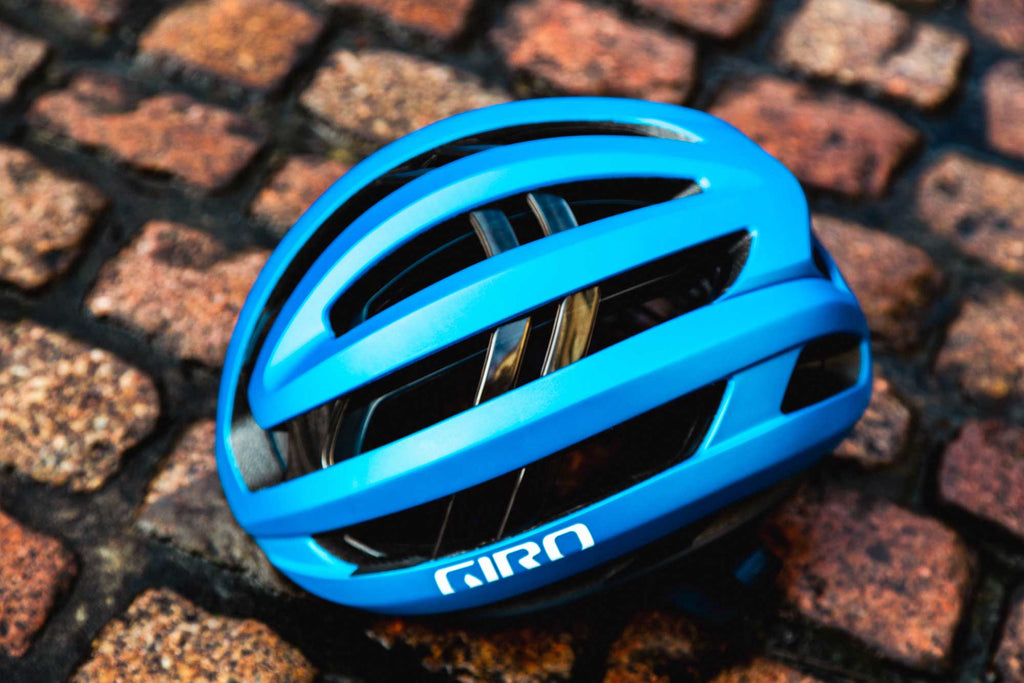We all want a helmet that prioritises safety and it’s fair to say that Giro’s most recent premium road offering, the Giro Aries Spherical Helmet, does exactly that. It features the brand’s Spherical Technology powered by Mips, a dual-layered rotational safety system whereby each layer has its own density of EPS foam and rotates against the other on impact to dissipate forces on impact. The Aries also has a new, proprietary Aura (Aerodynamic Ultimate Reinforcing Arch) II Reinforcement Arch which is composed of two translucent, shatter-resistant twin bridges that run through the helmet, providing, so Giro says, structural integrity without adding weight.
Such attention to safety features means Giro’s Aries has been suitability rewarded by Virginia Tech (university researchers who provide unbiased helmet safety ratings) with the company ranking the Aries number one for safety out of all the helmets it has ever tested. This means it knocks the Specialized Tactic 4 off the top spot, an impressive feat considering the Specialized lid is a bulky helmet made especially for e-biking and enduro mountain biking.
So safety is one element when it comes to creating the best cycling helmets, and perhaps the most crucial, but it isn’t the only factor that both amateur and professional cyclists take into consideration when considering which lid to go for. Weight, breathability and aesthetics aren’t something that most riders want to compromise on for safety benefits, and it's for this reason that Giro has tried to strike a balance between a helmet that looks and feels good, but also ticks the boxes for safety rankings like Virginia Tech.
 When it comes to aesthetics, the Aries still features Giro’s distinct design, but it has a lower profile than the brand’s former flagship road helmet, the Aether. This means the overall design is sleeker and the helmet sits closer to the head, avoiding that dreaded mushroom-esque look. Giro says the Aries is 5% lighter than the Aether too, and 2.3% cooler thanks to its frontal vents. Aerodynamics haven’t been forgotten either, with the reduced frontal area and chamfered edges on the Aries reducing aerodynamic drag by 4% over the Aether Spherical.
When it comes to aesthetics, the Aries still features Giro’s distinct design, but it has a lower profile than the brand’s former flagship road helmet, the Aether. This means the overall design is sleeker and the helmet sits closer to the head, avoiding that dreaded mushroom-esque look. Giro says the Aries is 5% lighter than the Aether too, and 2.3% cooler thanks to its frontal vents. Aerodynamics haven’t been forgotten either, with the reduced frontal area and chamfered edges on the Aries reducing aerodynamic drag by 4% over the Aether Spherical.
There are some brand new features to the Aries too, such as Giro’s DryCore sweat management system. This unique pad innovation utilises an internal silicone bead which is said to redirect moisture away from the rider's brow and eliminate the irritation of sweat dripping into the eyes. The Aries also features grippy rubber pads where eyewear is stashed in order to stop sunglasses from slipping out of the helmet, as well as Giro’s Roc Loc 5+ adjustable retention system.
The test
One of Giro’s key selling points when it comes to the Aries is the ‘barely-there’ feel it has on the head. Giro’s brand manager, Peter Nicholson, claims that the Aries “virtually disappears when you start riding”, and, while this might be a slight exaggeration, it’s not far from the truth. The Aries is incredibly comfortable with minimal padding that’s placed just where you need it most – at the very top of the helmet and around the front where the DryCore sweat management system is.
 The dual-layered Spherical Technology powered by Mips means that you don’t get the usual thin, yellow, plastic layer that comes with normal Mips technology, avoiding the issue of getting hair caught in the helmet when taking it off. The retention system can be dialled up for a tight fit against the head, but it never feels like there are any pressure points and it has space for a ponytail to slot through too, a bonus for those with longer hair. The conventional buckle on the Aries is easy to use and adjust – I never had any problems with it causing discomfort or friction on my skin, and a long strap means that it will fit a wide range of face and head shapes.
The dual-layered Spherical Technology powered by Mips means that you don’t get the usual thin, yellow, plastic layer that comes with normal Mips technology, avoiding the issue of getting hair caught in the helmet when taking it off. The retention system can be dialled up for a tight fit against the head, but it never feels like there are any pressure points and it has space for a ponytail to slot through too, a bonus for those with longer hair. The conventional buckle on the Aries is easy to use and adjust – I never had any problems with it causing discomfort or friction on my skin, and a long strap means that it will fit a wide range of face and head shapes.
I am a big fan of the shape of Giro’s Aries helmet; it sits close to the head, similarly to the Kask Protone Icon, and has a far more streamlined look than helmets like the Specialized S-Works Prevail which is a lot bulkier. The Aries provides good, low coverage on the rear of the helmet too, all while still weighing only 265 grams in a size medium. The grippers to help keep sunglasses secure when stored in the helmet is a nice idea, but I still felt like my glasses lacked a bit of security when riding along (though this could differ depending on the model and shape of the glasses.)
 When it comes to ventilation, I found the helmet to be breathable enough even when on long climbs, I didn’t feel any sweat building up on my eyebrows or forehead when riding in sunny temperatures of around 15 degrees. Giro says it has used its in-house windtunnel and Therminator (a one-of-a-kind heat-sensing head form) to create the perfect helmet shape when it comes to breathability, with 24 vents and deep internal channelling. These vents certainly make the helmet cool, which was an asset in warmer temperatures, but it also meant that I experienced a very cold head when riding in the UK winter and needed to add an extra layer underneath the helmet to protect me from the chill. The brand’s more aero-focussed Giro Eclipse Spherical has fewer vents so could be a better option if you are regularly riding in cold temperatures.
When it comes to ventilation, I found the helmet to be breathable enough even when on long climbs, I didn’t feel any sweat building up on my eyebrows or forehead when riding in sunny temperatures of around 15 degrees. Giro says it has used its in-house windtunnel and Therminator (a one-of-a-kind heat-sensing head form) to create the perfect helmet shape when it comes to breathability, with 24 vents and deep internal channelling. These vents certainly make the helmet cool, which was an asset in warmer temperatures, but it also meant that I experienced a very cold head when riding in the UK winter and needed to add an extra layer underneath the helmet to protect me from the chill. The brand’s more aero-focussed Giro Eclipse Spherical has fewer vents so could be a better option if you are regularly riding in cold temperatures.
 The DryCore sweat management system did its job to a certain extent, but I still struggled with some sweat dripping into my eyes when stopped at the top of a long climb in warmer temperatures, although this was significantly less than with other helmets I own.
The DryCore sweat management system did its job to a certain extent, but I still struggled with some sweat dripping into my eyes when stopped at the top of a long climb in warmer temperatures, although this was significantly less than with other helmets I own.
Costing £289.99, the Giro Aries Spherical is one of the most expensive helmets on the market, but this is a price point that is similar to that of other premium road helmets like the Kask Protone Icon and Specialized S-Works Prevail. There are certainly cheaper options out there, but, given the Virginia Tech rating, there is no disputing that the Aries Spherical is the safest of them all. If that’s your priority, then the Aries is a great investment – it gives peace of mind while out on the road that you’re fully protected while also having high levels of breathability, comfort and it looks great.






























